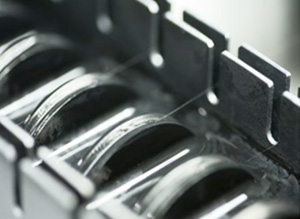WIRECOAT
DIE LUBRICANT FOR HOT DRAWING FINE TUNGSTEN, MOLYBDENUM & IRRIDIUM WIRE DRAWING
WIREECOAT is a proven indigenousSubstitute for the “AQUADAG 1050".
WIRECOAT-2055 is an indigenous proven product, successful in functional tests, when used with applicators such as Spraying systems, Pumping systems – centralised or localised, Roller systems and Compressed air bubbling systems for coating Tungsten, Molybdenum & Irridium wires prior to drawing. The coated wires are heated to drawing temperatures and the drawn through heated Tungsten carbide or a series of Diamond dies to form smooth wires of uniform preferred cross section. The wires are then annealed and coiled and cut to form filaments for GLS and Auto lamps and other allied applications.
WIRECOAT-2055 has been tested for shelf life, suspension properties and pot-life when in use and when left standing. RUGRAF shows excellent film forming properties when dried and exhibits adsorptive qualities when the dried film adheres to substrates such as glass and metals.
WIRECOAT is a concentrated dispersion of pure ultra fine graphite particles in water.

TYPICAL PROPERTIES
Consistency : Thixotropic. It forms a weak gel on standing. Mild stirring/agitation breaks the gel structure and properties of a liquid become evident.
Density : 1.10 Kgs/litre Tested using a hydrometer for heavy liquids or by employing gravimetric methods.
PH : 8.50 to 10.0 Electrometric measurement of ph, using Beckman or equivalent digital ph – meter, with glass electrode for alkaline solutions, calomel electrode and temperature compensator.
Solid Contents :20 gm% to 22 gm% w/w , By gravimetric method.Being thixotropic it gels on standing. The degree of gelling is no indication of solid content.
Shelf – life :1 Year.
STABILITY WITH OTHER CHEMICALS
WIRECOAT is stable with anionic or non-ionic chemicals such as wetting agents or emulsifiers, water miscible solvents such as alcohols, glycols and other polar solvents, disinfectant/surfactant such as cresol and thickeners such as Agar-Agar, sugar solution or Caragenan.
It is not compatible with non-polar or water immiscible solvents. Mineral acids will completely & irreversibly precipitate the graphite from suspension and cause the graphite particles to settle down as sediment leaving a clear aqueous supernatant.
STORAGE AND HANDLING
Vessels made of Stainless steel, or steel coated with rust resistant material, or FRP should be used for this product. Tanks, piping and handling equipment should be cleaned with plain soap and water, to remove any deposits due to evaporation. Freezing temperatures during storage must be avoided.
TOXICITY AND HANDLING
RUGRAF causes only minor transient skin and eye irritation. Use of protective clear goggles and approved respirators for protection against dust is recommended. Work place air-borne concentration of dried RUGRAF dust should not exceed 6mg/m3, total mass.
SHIPPING
RUGRAF is supplied in 20Kgs and 40Kgs. Carboy packing.
PRECAUTIONS
RUGRAF should be stored in a cool dry place and should not be allowed to freeze. Containers should be tightly resealed after use to prevent loss of ammonia vapours. Rugraf should not be mixed/diluted with any diluents having an acidic ph.
DILUTION OF WIRECOAT
WIRECOAT is a concentrate and should normally be diluted before use with distilled, demineralised or soft water, dilution should be carried out by adding water to the concentrate not the reverse. Water should be added slowly with constant stirring until a fluid consistency is obtained. The remaining water may be added more rapidly until required dilution is reached.
DILUTION RATIOS
Recommended dilution ratio.
A ratio of one part Wirecoat to 3 parts water v/v is proposed for startup, for single drawing with Tungsten carbide dies for larger wire sizes.
Ratios of 1:8 or 10 are common during production with multiple drawing machines with a series of diamond dies for finer wire sizes.
The dilution ratios generally vary with wire size, quality/source of the metal used, drawing machine torque or drawing speed and temperature.
DRAWING TUNGSTEN, MOLYBDENUM & IRRIDIUM WIRES & MONITORING OF DEFECTS:
A proper “cause and effect" study becomes a must to ascertain the exact cause of the defect, as the variables are many.
If problems in drawing of Tungsten, Molybdenum & Irridium wires are being encountered, it is very important to consider a number of fault guidelines. The most common defects encountered during wire drawing are shown.
Breakage of wire.
Quick die shoot out.
Rough drawn wire.
Twist in drawn wire.
Reduced Tensile strength of drawn wire.
Wire size lower than the size of the die.
Dull & patchy appearance of the wire.
The above defects may be caused due to any or all of the following probable faults.
IN THE PREPARED LUBRICANT
Excessive dilution of Rugraf or improper mixing or use of tap water having acidic ph due to chlorination.
Insufficient thickener – Agar agar causes “low pickup of lubricant onto wire".
Improper wetting – due to greasy wire. Use surfactants like cresol or any other wetting agents.
Use after expiry date – degenerated lubricant.
OR PROBABLE FAULTS IN THE RUNNING OF THE DRAWING MACHINE
Insufficient drawing temperature can cause work hardening and reduced TS leading to breakage &
die-wear.
Excessive temperature can cause wire elongation and breakage of wire.
Run-out in the drawing cylinder and/or spool of the machine.
Jerky operation in the gearbox of the drawing machine.
Highly oxidising flame.
OR PROBABLE FAULTS IN THE DIET AND RAW BEING USED
Roughness in die – orifice can cause a twist in the wire.
Unclean or clogged die – orifice, dies need polishing.
Abnormal or excessive reduction in size.Low quality of the wire being drawn.